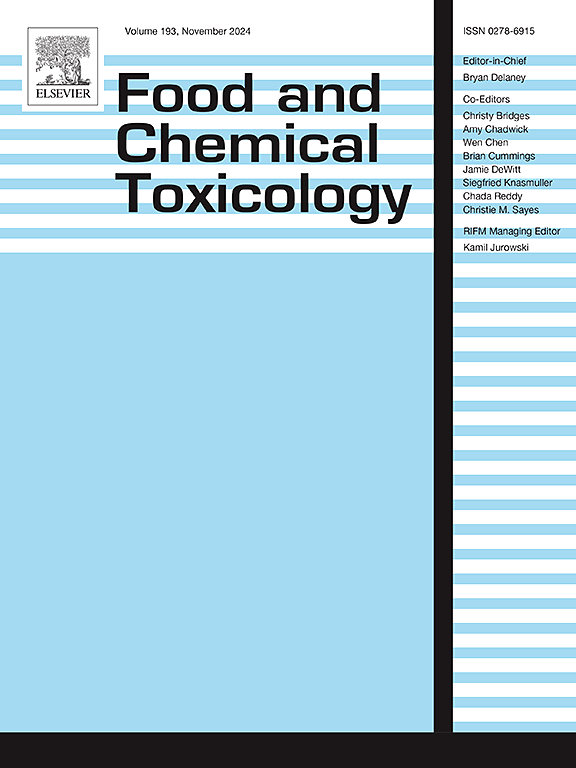Quantitative evaluation of food-relevant heterocyclic aromatic amines in water samples for agricultural and human use. Selective extraction and cancer risk assessment
IF 3.9
3区 医学
Q2 FOOD SCIENCE & TECHNOLOGY
引用次数: 0
Abstract
Heterocyclic aromatic amines (HAAs) are organic pollutants originating from several emission sources and pose significant health risks. There is a gap in information regarding their concentration levels in environmental samples. This study presents a novel methodology for the extraction and preconcentration of HAAs in waters. The proposed methodology employs a μSPE strategy followed by ultra-high-performance liquid chromatography coupled to mass spectrometry determination. This methodology demonstrated a satisfactory alignment with the principles of green chemistry. The concentrations of HAAs detected ranged from non-detectable levels to 0.15 μg L−1 in irrigation water samples collected from rural areas, and up to 0.49 μg L−1 in urban areas. Additionally, drinking and bottled water samples exhibited concentrations ranging from 0.24 to 1.60 μg L−1. Significantly lower concentrations of HAAs were observed in mineral water samples. Finally, an analysis of the incremental lifetime cancer risk associated with ingesting HAAs-contaminated water was conducted.
农业和人类用水水样中与食品有关的杂环芳香胺的定量评价。选择性提取和癌症风险评估。
杂环芳香族胺(HAAs)是一种来自多种排放源的有机污染物,具有重大的健康风险。关于它们在环境样品中的浓度水平的信息存在空白。本研究提出了一种提取和富集水中HAAs的新方法。该方法采用μSPE策略,然后采用超高效液相色谱联用质谱法测定。这种方法证明了与绿色化学原则的令人满意的一致性。在农村地区的灌溉水样品中,检测到的HAAs浓度从无法检测到0.15 μg L-1,而在城市地区则高达0.49 μg L-1。此外,饮用水和瓶装水样品的浓度范围为0.24至1.60 μg L-1。在矿泉水样品中观察到明显较低的HAAs浓度。最后,对摄入砷化砷污染的水所导致的终生癌症风险增量进行了分析。
本文章由计算机程序翻译,如有差异,请以英文原文为准。
求助全文
约1分钟内获得全文
求助全文
来源期刊

Food and Chemical Toxicology
工程技术-毒理学
CiteScore
10.90
自引率
4.70%
发文量
651
审稿时长
31 days
期刊介绍:
Food and Chemical Toxicology (FCT), an internationally renowned journal, that publishes original research articles and reviews on toxic effects, in animals and humans, of natural or synthetic chemicals occurring in the human environment with particular emphasis on food, drugs, and chemicals, including agricultural and industrial safety, and consumer product safety. Areas such as safety evaluation of novel foods and ingredients, biotechnologically-derived products, and nanomaterials are included in the scope of the journal. FCT also encourages submission of papers on inter-relationships between nutrition and toxicology and on in vitro techniques, particularly those fostering the 3 Rs.
The principal aim of the journal is to publish high impact, scholarly work and to serve as a multidisciplinary forum for research in toxicology. Papers submitted will be judged on the basis of scientific originality and contribution to the field, quality and subject matter. Studies should address at least one of the following:
-Adverse physiological/biochemical, or pathological changes induced by specific defined substances
-New techniques for assessing potential toxicity, including molecular biology
-Mechanisms underlying toxic phenomena
-Toxicological examinations of specific chemicals or consumer products, both those showing adverse effects and those demonstrating safety, that meet current standards of scientific acceptability.
Authors must clearly and briefly identify what novel toxic effect (s) or toxic mechanism (s) of the chemical are being reported and what their significance is in the abstract. Furthermore, sufficient doses should be included in order to provide information on NOAEL/LOAEL values.
 求助内容:
求助内容: 应助结果提醒方式:
应助结果提醒方式:


